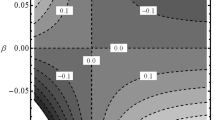Abstract
In a setting where the owner of a company delegates the authority to make overlapping capacity investments to a manager, the decision on such investments depends on how the decision-maker perceives the marginal cost of capacity. This covers the cost for one additional unit of capacity made available for only one period of time, although expenditures for capacity investments are a common cost of capacity that can be used over multiple periods. If the manager’s performance measure is residual income, the level of the marginal cost of capacity and the associated investment incentives depend on the applied depreciation schedule and the manager’s time preferences. We examine the direction of the effect of several depreciation schedules on the marginal cost of capacity that the manager perceives and analyze the extent to which this cost is distorted. Our analysis shows that a performance measure based on residual income, combined with several practically relevant depreciation schedules, creates the desired investment incentives for the manager, because differently structured depreciation schedules have a relatively small effect on the level of the marginal cost of capacity. We also examine how partial direct expensing can increase the objective congruence of residual income as a managerial performance measure if the straight-line depreciation schedule or the annuity depreciation schedule is used.








Similar content being viewed by others
References
Arrow, K. (1964). Optimal capital policy, cost of capital and myopic decision rules. Annals of the Institute of Statistical Mathematics, 1–2, 21–30.
Baldenius, T., & Reichelstein, S. (2005). Incentives for efficient inventory management. The role of historical cost. Management Science, 51, 1032–1045.
Baldenius, T., & Ziv, A. (2003). Performance evaluation and corporate income taxes in a sequential delegation setting. Review of Accounting Studies, 8, 283–309.
Barton, A. (1984). The anatomy of accounting. St Lucia: University of Queensland Press.
Colditz, B., Gibbins, R., & Noller, G. (1988). Australian accounting. Sydney: McGraw-Hill.
Dutta, S., & Reichelstein, S. (1999). Asset valuation and performance measurement in a dynamic agency setting. Review of Accounting Studies, 4, 235–258.
Dutta, S., & Reichelstein, S. (2002). Controlling investment decisions. Depreciation and capital charges. Review of Accounting Studies, 7, 253–281.
Friedl, G. (2007). Ursachen und Lösung des Unterinvestitionsproblems bei einer kostenbasierten Preisregulierung. Betriebswirt, 67, 335–348.
Langen, H. (1953). Die Kapazitätsausweitung durch Reinvestitionen liquider Mittel aus Abschreibung. Z handelswissenschaft Forsch, 5, 49–70.
Lier, S., & Grünwald, M. (2011). Net present value analysis of modular chemical production plants. Chemical Engineering & Technology, 34, 809–816.
Lücke, W. (1955). Investitionsrechnung auf der Basis von Ausgaben oder Kosten? Z handelswissenschaft Forsch, 7, 310–324.
Nezlobin, A. (2012). Accrual accounting, informational sufficiency, and equity valuation. Journal of Accounting Research, 50, 233–273.
Nezlobin, A., Rajan, M. V., & Reichelstein, S. (2012). Dynamics of rate of return regulation. Management Science, 58, 980–995.
Pfeiffer, T., & Schneider, G. (2007). Residual income-based compensation plans for controlling investment decisions under sequential private information. Management Science, 53, 495–507.
Preinreich, G. (1938). Annual survey of economic theory. The theory of depreciation. Econometrica, 6, 219–231.
Rajan, M. V., & Reichelstein, S. (2009). Depreciation rules and the relation between marginal and historical cost. Journal of Accounting Research, 47, 823–865.
Reichelstein, S. (1997). Investment decisions and managerial performance evaluation. Review of Accounting Studies, 2, 157–180.
Reichelstein, S. (2000). Providing managerial incentives. Cash flows versus accrual accounting. Journal of Accounting Research, 38, 243–269.
Rogers, G. G., & Bottaci, L. (1997). Modular production systems. A new manufacturing paradigm. Journal of Intelligent Manufacturing, 8, 147–156.
Rogerson, W. (1997). Intertemporal cost allocation and managerial investment incentives. A theory explaining the use of economic value added as a performance measure. Journal of Political Economy, 105, 770–795.
Rogerson, W. (2008). Inter-temporal cost allocation and investment decisions. Journal of Political Economy, 116, 931–950.
Rogerson, W.P. (2011). On the relationship between historic cost, forward-looking cost and long run marginal cost. Review of Network Economics, 10(2), Article 2. doi:10.2202/1446-9022.1242
Webb, G. (1954). Depreciation of fixed assets in accountancy and economics. Sydney: Halstead Press.
Author information
Authors and Affiliations
Corresponding author
Rights and permissions
About this article
Cite this article
Lohmann, C. Managerial incentives for capacity investment decisions. J Manag Control 26, 27–49 (2015). https://doi.org/10.1007/s00187-015-0202-5
Published:
Issue Date:
DOI: https://doi.org/10.1007/s00187-015-0202-5




